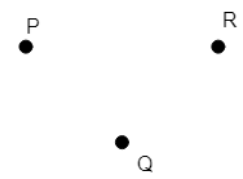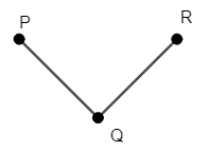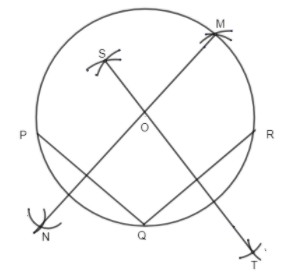
How many circles can be drawn through three noncollinear points
(a) only one
(b) two
(c) three
(d) infinite
Answer
517.2k+ views
Hint: To solve this question are should have knowledge of collinear points always lie in the same line while non-collinear never occurs all in the same line. Try drawing a circle or more using the given points and then check how many are possible.
We will first of all define certain terms to solve this question.
Collinear points – Three or more points are said to be collinear if they lie in the same straight line.
For example: In the figure below the points A, B and C are collinear.

Non – collinear point – Three or more points are called non – collinear points if they do not lie in the same straight line.
Example: In the figure below P, Q and R are non-collinear.

Here in this question, we are given three non-collinear points; let it be P, Q, and R. We will follow certain steps of construction to draw a circle using these points,

Step 1: Join PQ and QR.

Step 2: Using a compass draw perpendicular bisectors of line PQ and line QR. Name them as MN & ST respectively.

Le the point where they meet name as O.
Step 3: Taking O as the point on the compass and radius as OP draws a circle.

We have obtained only one circle using these three non-collinear points P, Q, and R.
Therefore only one circle can be obtained using three non-collinear points, which is an option (a).
Note: If the student has any possibility of confusion in the number of possible circles, then they can go for drawing more different perpendicular bisection the center O would anyway be the same. Hence the circle would also be the same. Therefore only one circle is possible.
We will first of all define certain terms to solve this question.
Collinear points – Three or more points are said to be collinear if they lie in the same straight line.
For example: In the figure below the points A, B and C are collinear.

Non – collinear point – Three or more points are called non – collinear points if they do not lie in the same straight line.
Example: In the figure below P, Q and R are non-collinear.

Here in this question, we are given three non-collinear points; let it be P, Q, and R. We will follow certain steps of construction to draw a circle using these points,

Step 1: Join PQ and QR.

Step 2: Using a compass draw perpendicular bisectors of line PQ and line QR. Name them as MN & ST respectively.

Le the point where they meet name as O.
Step 3: Taking O as the point on the compass and radius as OP draws a circle.

We have obtained only one circle using these three non-collinear points P, Q, and R.
Therefore only one circle can be obtained using three non-collinear points, which is an option (a).
Note: If the student has any possibility of confusion in the number of possible circles, then they can go for drawing more different perpendicular bisection the center O would anyway be the same. Hence the circle would also be the same. Therefore only one circle is possible.
Recently Updated Pages
Two men on either side of the cliff 90m height observe class 10 maths CBSE

What happens to glucose which enters nephron along class 10 biology CBSE

Cutting of the Chinese melon means A The business and class 10 social science CBSE

Write a dialogue with at least ten utterances between class 10 english CBSE

Show an aquatic food chain using the following organisms class 10 biology CBSE

A circle is inscribed in an equilateral triangle and class 10 maths CBSE

Trending doubts
Why is there a time difference of about 5 hours between class 10 social science CBSE

Write a letter to the principal requesting him to grant class 10 english CBSE

What is the median of the first 10 natural numbers class 10 maths CBSE

The Equation xxx + 2 is Satisfied when x is Equal to Class 10 Maths

Which of the following does not have a fundamental class 10 physics CBSE

State and prove converse of BPT Basic Proportionality class 10 maths CBSE




